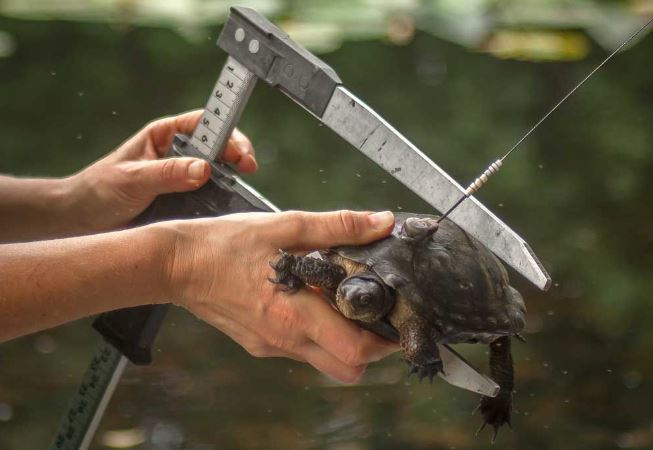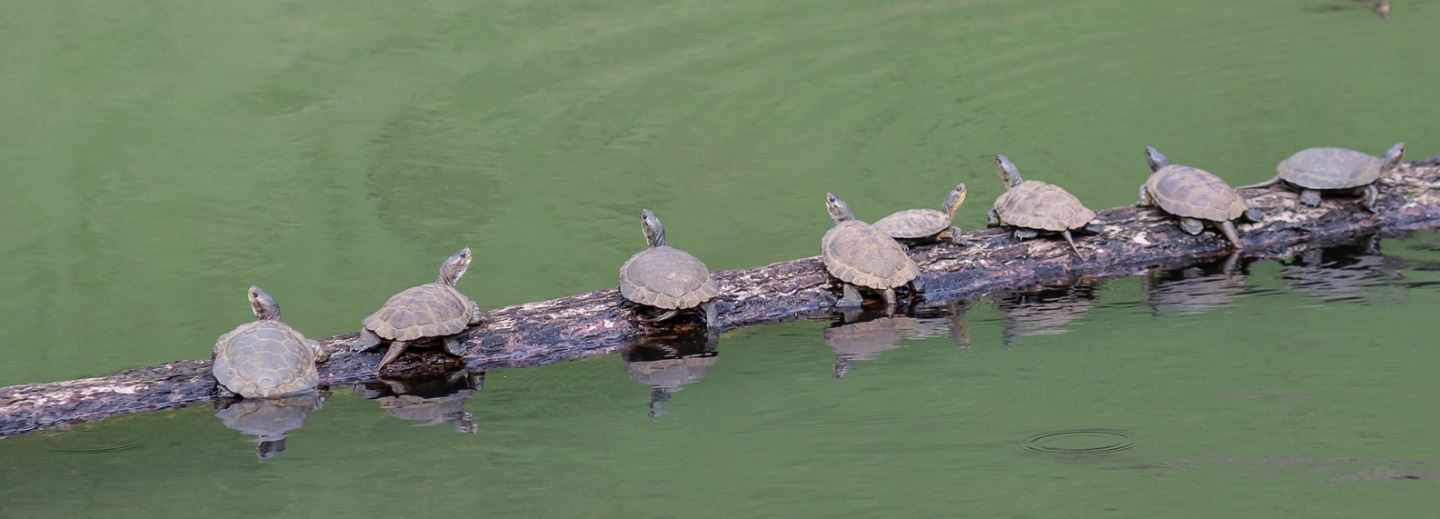The Dalles Chronicle (view source)
Washington biologists have been working hard to save the endangered western pond turtles in the Gorge, and new efforts are underway to diagnose and treat turtles suffering from a potentially fatal condition that is damaging shells of adult turtles in ponds near the Columbia River.
Shell disease is not the only problem for the turtles—loss of habitat and heavy predation by bullfrogs both remain a threat—but it is the most recent in a long list of issues biologists are seeking to counter.
 Stafanie Bergh, a biologist with Washington Fish and Wildlife, has been working on projects that include removing bullfrog adults, tadpoles and eggs, locating and monitoring turtle nests, and recovering eggs and newly hatched turtles for a “Head Start” program. At a recent media event at one of the four sites in the Gorge with western pond turtle populations, she explained the efforts state biologists have undertaken to aid the turtle’s recovery.
Stafanie Bergh, a biologist with Washington Fish and Wildlife, has been working on projects that include removing bullfrog adults, tadpoles and eggs, locating and monitoring turtle nests, and recovering eggs and newly hatched turtles for a “Head Start” program. At a recent media event at one of the four sites in the Gorge with western pond turtle populations, she explained the efforts state biologists have undertaken to aid the turtle’s recovery.
The most immediate threat is bullfrogs, she said. Newly-hatched turtles are slightly bigger around than a quarter, and literally float on the water like little bobbers. They are easy prey for bullfrogs, which can also eat rats and mice.
The “Head Start” program was founded in 1991. Eggs and young are collected and reared in captivity at zoos until they are too large for the frogs to eat—about as big around as a baseball—which takes two years. In the spring, breeding adults are monitored via radio transmitters from early to mid-June. “We monitor them every day, all day, waiting from them to leave the water to nest,” Bergh explained. When they do, she and her team flag the nest location.
The program has been very successful, with many young surviving into maturity. In 1993 the turtles were listed as endangered in Washington state, and a recovery plan completed in 1999 called for four populations in the Gorge, with natural recruitment and secure habitat. There are now four turtle sites in the Gorge, and 1,499 Head Start turtles have been released over 28 years.
In 2015, an intensive program was started to decrease bullfrog predation. In spring and summer, a contractor works the ponds every other night, spotlighting bullfrogs and their tadpoles and gigging them with a trident spear, as well as removing egg masses. “Bullfrog egg masses can hatch in only 48 hours, and one egg mass can contain 20,000 eggs,” Bergh explained. The bullfrogs may never be completely eradicated. “We have to remain vigilant for a long time.”
Biologists started to notice adult turtles suffering from shell disease in 2012. Once they realized what was going on, they were able to find evidence going back as early as 2003. The disease progresses very slowly, but turtles live a long time, up to 50 years in the wild. “We don’t know yet if it is fatal, or if it affects reproduction,” Bergh said. Nor do they know the cause or the best treatment. “It may have something to do with captivity, and the Head Start program, but we don’t know yet,” she added.
This month, Bergh is capturing infected turtles for treatment. Researchers will be seeking to understand if the disease is related to bone density, water quality, diet, the microbiome, or something else entirely, she said. Those some of the research questions being considered. “We don’t even know if it’s contagious. It hasn’t spread to the painted turtles, which share the same ponds,” she said.
Treatment for the disease includes surgically removing the lesions, and turtles are trapped following the nesting season. Treatment takes most of the fall, and the turtles are then cared for by prison inmates over the winter. They are out of the ponds for almost a year.
“Turtles are really slow about doing everything,” Bergh said.
Despite the success of the programs, the shell disease has difficult to deal with. “It’s pretty depressing to have this happen,” said Bergh. “We’ve done such good work, for such a long time, to reestablish these turtles.”
But Bergh is hopeful the recovery will continue as WDFW. along with partners that include the Oregon Zoo, Woodland Park Zoo, PAWS, the United States Forest Service, Friends of the Columbia Gorge, Shedd Aquarium, University of illinois, VCA Hospitals and the Sustainability in Prisons Project, work together to ensure western pond turtles have a chance to thrive in Washington.
She estimates as many as 1,000 turtles make their home in the Gorge, and people eager to see them protected. “Pretty much everyone I’ve met loves turtles.”
Returning from a floating turtle trap, baited with a can of sardines, Bergh held up a pair of young turtles the size of her palm: too big now for a bullfrog to eat, and born and raised on the site. “This is the whole goal, this is what we are looking for,” she said with a smile. “Healthy, young wild turtles.”
Photo: A Western pond turtle with a radio transmitter is measured, weighed and photographed after being captured as biologists look for turtles suffering from a shell disease. (photographer: Mark and Flora Gibson)

